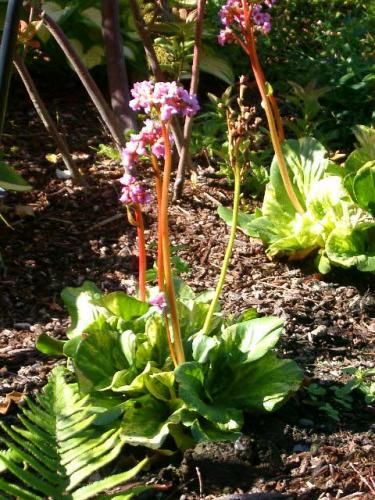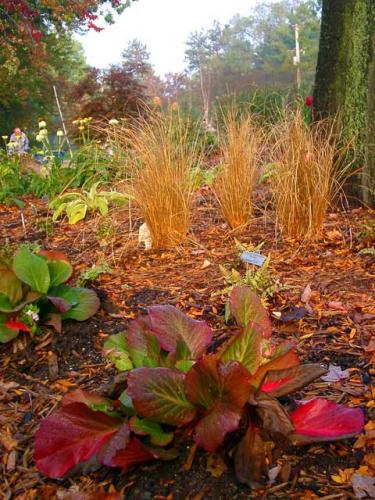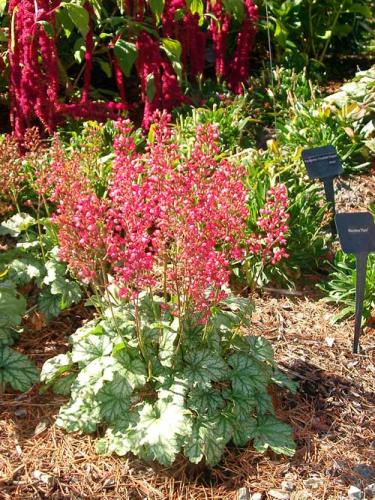Smart plants: Understanding what makes up a perennial garden
Matching perennials to your site conditions or garden soil will help you have successful, long-lasting perennial gardens.
A wise professor once defined a perennial as “a garden plant – had it lived, would return year after year.” Loosely defined, perennials will continue growing for several or many years in the optimum environment. The gardener’s term “perennial” commonly means “hardy, herbaceous, ornamental plants.” Hardy perennials are, with a few exceptions, non-woody plants having roots that live through the winter while the tops die back to the ground, particularly in northern climates. A few perennials such as Heuchera (coral bells), Iberis (candytuft) or Bergenia (pig squeak) are semi-evergreen, sporting green or colorful leaves that will survive the winter cold.


Perennials can be chosen for both flower color and interest in foliage. Bergenia, commonly known as “pig squeak,” also has rich fall color. Photo credits: Rebecca Finneran, MSUE (both)
Some perennials will live almost indefinitely while others tend to be short-lived and may last in the home garden only a few seasons. For instance, peonies and daylilies are plants that may be found on a farmstead long after the home and barn are gone, while coral bells, lupine and balloon flower may be shorter lived.
Perennial, not perpetual
What defines horticulture versus other areas of plant science is the words “culture or cultivated.” This science encompasses what it takes to grow plants outside of their natural environment such as in the garden. For instance, coral bells can be long-lived perennials if they have ample drainage, good air movement and the right amount of sun. Lupines will also live in a garden for quite a while if they are well matched to the soil type. Balloon flowers are magnets for deer and vole feeding. Gardeners who employ simple, hand-made barriers may enable this plant to survive for many years. So the life expectancy of many perennials is really up to how the gardener chooses and cultivates them.

Heuchera (coral bells) are great perennials, sporting both colorful flowers and foliage.
Photo credit: Rebecca Finneran, MSUE
Michigan State University Extension recommends researching the site requirements for the perennials you wish to plant. Another wise professor once said, “Fortunately for us, plants can’t read books.” Since we can’t match soil and growing conditions for each individual perennial, successful garden displays are often the result of years of trial and error. When selecting plants, remember perennial doesn’t mean perpetual!
Unlike annuals, perennials have a shorter season of bloom, specific to each variety. While plant breeders continually look for perennial cultivars that re-bloom or have long-lasting blooms, they still will not be in flower for months at a time. To enhance the enjoyment of perennials, researchers continually seek new clones with different bloom periods coupled with attractive, even colorful foliage.
Gardeners can also enjoy perennial blooms by “cultivating” them in a way to enhance the display or delay bloom. Much research has been done on pruning perennials for just this reason. Both a plant’s character (fullness) will be affected with pruning as well as a delay in bloom. Pruned at different intervals, tall phlox, for example, may have a one to two week delay in bloom, thus helping to extend the “show.”
Some horticultural texts refer to perennials that are “woody.” Perennials indeed can develop underground root structures that are quite dense and woody. Peony and Baptesia (False Indigo) are two that come to mind that create this woody tissue. Other plants like Vitex and butterfly bush are classified as a woody shrub, but sometimes the tops will die back to the ground each season like the herbaceous perennials including daylily. Either way, these plants are excellent candidates for a mixed perennial garden!
For more information on a wide variety of smart gardening articles, or to find out about smart gardening classes and events, visit the Gardening in Michigan website.
Additional references for smart plant selection



 Print
Print Email
Email



